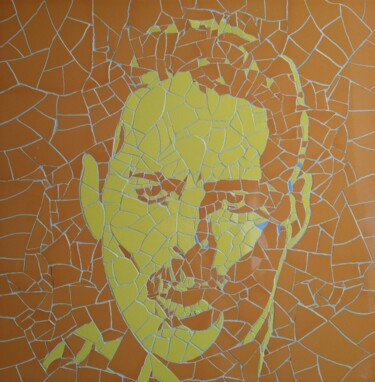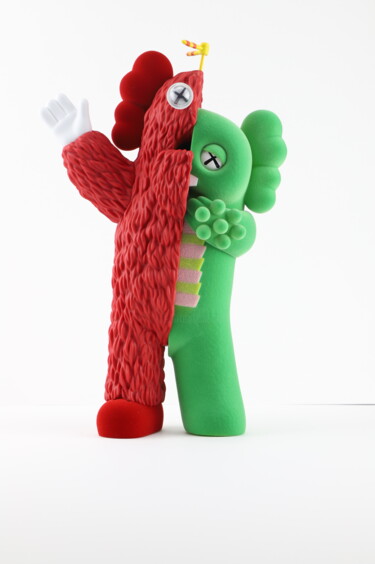
419 Original Contemporary Sculptures For Sale:
How to define Pop Art style?
Pop Art is an art movement that first appeared in the 1950s and reached its peak in the 1960s in both America and Britain, drawing inspiration from sources in popular and commercial culture. It started out as a response against the prevailing theories of art, culture, and what art ought to be. Young artists believed that what they learned in art school and what they observed in museums had little to do with their daily lives or the surroundings. Instead, they employed imagery from Hollywood films, popular culture, including comic books, advertisements, product packaging, and other commercial media, in a striking break from conventional artistic technique to produce paintings and sculptures that embraced everyday life in the most literal sense. Pop Art has evolved into one of the most influential contemporary art movements, maybe as a result of the inclusion of commercial imagery.
By using iconography from popular and mass cultures the movement presented a challenge to high art traditions.Through the use of images from popular culture in art, most often through sarcasm, it emphasizes the banal or basic elements of any civilization. It also has to deal with the methods that artists employ for mechanical duplication or depiction. In pop art, elements are occasionally clearly isolated, combined, or removed from their usual context.
Numerous changes in art trends have occurred over time, and every time, new and innovative works of art have been produced by artists. Every creative endeavor pays homage to the past while simultaneously setting the road for the future by inventing new forms. The Pop Art movement pioneered the fusion of high and low culture and created some of the most memorable artworks of the 20th century. Painting and sculpture were revolutionized by artists from all over Europe, including France, England, Italy, Sweden, and the United States, by showing common, mass-produced items that had never before been taken seriously as subject matter or content for art.
Among the most famous artists of Pop Art are Roy Lichtenstein, Keith Haring, Robert Rauschenberg, Richard Hamilton, Andy Warhol, David Hockney, Robert Indiana, James Rosenquist, Alex Katz, and Takashi Murakami.
Pop Art Sculpture
The Pop Art movement attempted to blur the distinction between "high" art and "low" culture by producing paintings and sculptures of pop culture icons. One of the most influential aspects of Pop Art is the idea that there is no hierarchy of cultures and that art can borrow from any source. People who wanted to purchase Pop Art knew that less-appreciated materials had taken the place of "noble materials" like wood or bronze and had been blended with everyday objects. This had opened up new possibilities for pop art sculpture and led to the development of what we know today.
Robert Indiana's LOVE sculpture is unquestionably the movement's most recognizable piece of art, as well as Andy Warhol's sculptural Brillo and Campbell's tomato juice boxes that so powerfully shook the art world and pushed the limits of what constituted art, but other achievements such as the soft sculptures by Claes Oldenburg representing everyday objects with monumental dimensions, greatly participated in the development of the movement. Other sculptors such as George Segal, Jeff Koons or even Richard Orlinski will also mark the history of Pop Art sculpture.
Pop Art Sculptors
Eduardo Paolozzi (1924 - 2005)
A significant figure in the British post-war avant-garde was the Scottish sculptor and artist Eduardo Paolozzi. He is considered as one of the early pioneers of pop art. His collage “I Was a Rich Man's Plaything”, which combined popular culture items including a pulp fiction book cover, a Coca-Cola advertisement, and a military recruitment poster, served as a crucial Pop Art movement fundamental piece. The piece is an excellent example of British Pop Art's darker side, which focused more on the contrast between American popular culture's glitter and wealth and British reality's economic and political misery. The influence of technology and mass culture on high art was highlighted by Paolozzi, a member of the loosely affiliated Independent Group. Although he worked in many other media throughout his career and always referred to his work as surrealist art, he became more strongly linked with sculpture.
Claes Oldenburg (1929 - 2022)
American sculptor Claes Oldenburg is well known for his large-scale replicas of everyday objects that he used in his public art installations. Soft sculpture versions of everyday objects is another important theme in his work. Oldenburg is renowned for creating humorously ludicrous sculptures of food and inanimate objects. His well-known collection of such pieces was first shown in the artist's 1961 Lower East Side, New York, installation named "The Store." Oldenburg produced strawberry shortcake and candied apples as plaster sculptures for the project. Oldenburg's installation, which was set up like a conventional variety store and sold his goods at low costs in addition to copying consumer goods, made a statement about the relationship between art objects and commodities. The sculptures in “The Store” were painstakingly hand-built, despite being presented as if they were mass-produced, and the lush, expressive brushstrokes that cover the objects in Pastry Case seem to parody the gravity of Abstract Expressionism, a prevalent topic in Pop Art. In a very ironic setting, Oldenburg blends the commodity item with an emotive expressionist gesture.
Robert Indiana (1928 - 2018)
American artist Robert Indiana was a part of the pop art movement. In the shape of a card that he delivered to various friends and acquaintances in the art world, he initially developed his iconic image LOVE in 1964. Robert Indiana was asked to create an artwork for the Museum of Modern Art's annual Christmas card in 1965. Based on his LOVE picture, Indiana submitted three 12" square oil on canvas variants. Red, blue, and green were chosen by the museum as being the most powerful color combinations. It quickly rose to the top of the most popular cards the museum has ever sold. In 1966, Indiana collaborated with Marian Goodman of Multiples, Inc. to create his first LOVE sculpture in aluminum as he continued to build his LOVE series. Indiana finished his first enormous LOVE sculpture in Cor-Ten steel in 1970.
George Segal (1924 - 2000)
American painter and sculptor George Segal was a part of the pop art movement. Despite beginning his artistic career as a painter, Segal is best known for his cast life-size figures and the tableaux they appeared in. Segal invented the use of plaster bandages (plaster-impregnated gauze strips meant for producing orthopedic casts) as a sculptural media in place of conventional casting methods.
Marisol (1930 - 2016)
While men dominated American Pop Art, a few women, including Marisol, participated in exhibitions alongside them. However, her creations didn't always adhere to the rigid iconography of Pop. Her blockish inert sculptures that wittily reference fashion, family, and movie stars are most recognized for fusing folk art and assemblage.
Jasper Johns (born 1930)
One of the most famous living artists in the world is Jasper Johns. Nearly all artistic movements from the 1950s to the present have been influenced by his work in painting, sculpture, and printmaking, including Abstract Expressionism, Neo Dada, and the Pop Art movement. Johns was one of the artists who helped the Pop Art movement embrace consumer society. His Pop Art pieces primarily feature signs like flags, targets, and maps. In actuality, the painting Flag, one of the most recognized pieces of the Pop Art movement, is his best-known creation. It is believed that he made it after seeing the American flag in a dream. His creations constantly receive millions of dollars at auction and sale, and they frequently set records for the highest sum ever paid for a work by a living artist.
Jeff Koons (born 1955)
American artist Jeff Koons is renowned for his works that deal with popular culture and his sculptures that feature everyday objects, such as balloon animals made of stainless steel with mirror-finish surfaces. His sculptures have gained high prices, with at least two of them setting auction records for works by living artists: Balloon Dog (Orange) in 2013 sold for US$58.4 million, and Rabbit in 2019 for US$91.1 million.
Keith Haring (1958 - 1990)
American artist Keith Haring's pop art emerged from the 1980s New York City graffiti scene. His animated aesthetic has developed into a well-known visual language. A large portion of his art contains sexual allusions that were turned into social action by using the images to promote AIDS awareness and safe sex. Haring's reputation increased as a result of his spontaneous chalk drawings of people, dogs, and other stylized motifs on bare black advertising spots in the New York City subways. After becoming well-known, he produced vibrant, large-scale murals, several of which were commissioned. Between 1982 and 1989, he made more than 50 public works of art, many of them free of charge for hospitals, daycare centers, and schools. He expanded his practice by opening the Pop Shop in 1986. Through his own iconography, his later work frequently expressed political and sociological themes - anti-crack, anti-apartheid, safe sex, homosexuality, and AIDS.
Discover contemporary Pop Art Sculptures on Artmajeur
Contemporary Pop Art Sculptures are a form of original artwork that combines popular culture with sculpture. These sculptures are typically made out of a variety of materials such as plastic, fiberglass, and resin. They are often supported by metal frames or stands, allowing the artwork to stand tall and proud. What makes this type of artwork unique is its ability to transform everyday objects into works of art that are both visually stunning and thought-provoking. These sculptures challenge the traditional methods of sculpture by incorporating bright colors, bold patterns, and unexpected materials. This type of artwork is perfect for those who seek to add a pop of color and personality to their living or workspace.

©2023 N Nathan
Origins and History
Pop Art Sculptures emerged in the mid-20th century as a response to the consumerist and mass-produced culture of the time. Artists such as Claes Oldenburg, George Segal, and Tom Wesselmann were among the pioneers of this movement, which aimed to blur the boundaries between high art and popular culture.

©2023 Achab
Evolutions of theses works in the contemporary art market
Contemporary Pop Art Sculptures have been evolving rapidly in recent years, becoming more dynamic and expressive. The use of bold colors, unique materials, and innovative techniques has been prevalent in this genre, resulting in captivating and visually stunning pieces. These sculptures have become increasingly popular in the contemporary art market, with collectors and art enthusiasts alike seeking out these unique creations. The importance of these sculptures lies in their ability to capture the essence of popular culture while simultaneously pushing the boundaries of traditional sculpture.

©2023 Eric Montaux
Related Famous Artists
Contemporary Pop Art Sculpture is a modern art form that blends elements of popular culture and fine art. Several artists have gained recognition for their work in this field. Here are a few examples:
Jeff Koons Jeff Koons is an American artist known for his large-scale sculptures that often incorporate inflatable objects, such as balloons and pool toys. His work explores themes of consumerism and mass culture, and he is considered one of the most successful Contemporary Artists.
Takashi Murakami Takashi Murakami is a Japanese artist who has gained international acclaim for his brightly colored sculptures and paintings that merge traditional Japanese art with contemporary pop culture. His work often features cartoon characters and anime-inspired imagery.
Yayoi Kusama Yayoi Kusama is a Japanese artist known for her vibrant, immersive installations and sculptures. Her work often features polka dots and bright colors, and explores themes of infinity and the cosmos.
KAWS KAWS is an American artist known for his cartoon-inspired sculptures and paintings. His work often features the character of Companion, a Mickey Mouse-like figure with X’s for eyes. He has collaborated with several major brands, including Nike and Uniqlo.
Daniel Arsham Daniel Arsham is an American artist who creates sculptures that explore themes of time and decay. His work often features everyday objects, such as phones and cameras, that are rendered in materials that give them a weathered, archaeological appearance.
These artists have made significant contributions to the field of contemporary Pop Art Sculpture, and their work continues to inspire and captivate audiences around the world.

©2022 Diederik Van Apple Artist represented by art luxury gallery
Notable contemporary Pop Art Sculptures
Contemporary Pop Art Sculptures have been popular since the 1950s and continue to be so today. Here are some well-known examples:
"Balloon Dog" by Jeff Koons, created in 1994 - This sculpture is a large-scale representation of a dog made entirely out of shiny, metallic balloons. It is a playful and whimsical take on a traditional subject matter.
"Tulips" by Jeff Koons, created in 1995-2004 - This sculpture is a series of brightly colored, oversized tulips made of stainless steel. It is a vibrant and eye-catching piece that plays with the idea of mass production.
"Diamond Dust Shoes" by Andy Warhol, created in 1980 - This sculpture is a series of high-heeled shoes made of plaster and covered in diamond dust. It is a commentary on the glamour and excess of the fashion industry.
"Comedian" by Maurizio Cattelan, created in 2019 - This sculpture is a banana duct-taped to a wall. It is a provocative and controversial piece that questions the value of art and the role of the artist in society.
"LOVE" by Robert Indiana, created in 1964 - This sculpture is a large-scale representation of the word "love" in bold, colorful letters. It has become an iconic symbol of the Pop Art movement and has been reproduced in various forms and media.
Overall, Pop Art Sculptures are a fascinating and dynamic art form that continue to captivate audiences with their playful and provocative imagery.


Paolo Pastorino
Sculpture - Ceramics | 37x44x18 cm

Well Well
Sculpture - Acrylic | 170x60x30 cm

Achab
Sculpture - Plastic | 23.4x14.2x15.4 cm

Laurence Jenk
Sculpture - Plastic | 170x60x50 cm

Krzysztof Bendinger
Mosaic | 60x60x1.6 cm

Priscilla Vettese
Sculpture - Spray paint | 23x10x6 cm

Jordan Jeffray
Sculpture - Acrylic | 70x100x26 cm

Na$H
Sculpture - Acrylic | 19x13x13 cm

Maas Tiir
Sculpture - Resin | 35x29x19 cm

Esteban Vera (EVera)
Sculpture - Acrylic | 34x25x15 cm

Walid Sahraoui (Wally)
Sculpture - Acrylic | 81x5x5 cm
























